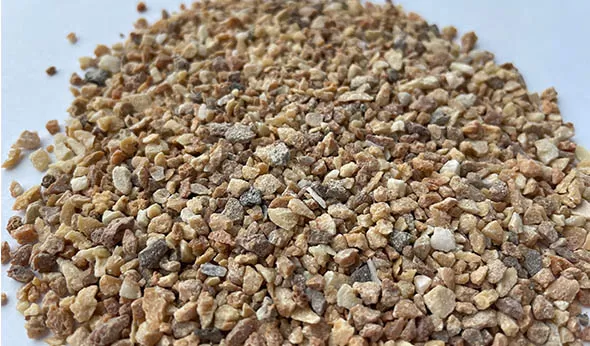Dead Burnd Magnesia
85%-92% Dead burned magnesiais mainly made of natural magnesite ore with 46% content, which is calcined by high temperature kiln at about 1400℃-1800℃.
Product Description
Dead-burned magnesia (DBM) is a kind of refractory magnesia, which is the raw material for manufacturing magnesia bricks and producing unshaped refractory materials. The finished products are used in steel making, electric furnace bottom and ramming furnace.
Msia Refractory Limited is located in Dashiqiao, the magnesium capital of the world, with rich natural magnesite resources and we also have a rotary kiln for DBM production with an annual output of 100,000 tons, which provides a competitive advantage for the efficient and economical production of dead burned magnesite.
Product Parameters
| Product Name | MgO (%) | SiO2 (%) | Al2O3 (%) | Fe2O3 (%) | CaO (%) | Loi (%) | BD (kg/cm3) | Package |
| DBM85 | 85 MIN | 7.0MAX | 0.7MAX | 0.6MAX | 5.0MAX | 0.8MAX | 3.10MIN | TON BAG (1.25) |
| DBM90 | 90 MIN | 4.8MAX | 1.0MAX | 0.7MAX | 4.0MAX | 0.6MAX | 3.15MIN | TON BAG (1.25) |
| DBM92 | 92 MIN | 4.8MAX | 1.0MAX | 0.7MAX | 3.5MAX | 0.5MAX | 3.15MIN | TON BAG (1.25) |
| Coarse Sizes | 1-15 mm, 3-15 mm, 5-15 mm, 3-8 mm, 5-10 mm, customizable | ||
| Small Fractions | 0-1 mm, 0.5-1 mm, 1-3 mm, 1-5 mm, 200 mesh, customizable | ||
| Packing | 1.35 Ton Bags, customizable | ||
| Colour | Brown | ||
Q: What is dead-burned magnesia?
A: Dead-burned magnesia, also known as DBM, is a highly refractory material produced by calcining or heating natural magnesite ore at extremely high temperatures, typically around 1700-1800°C (3092-3272°F). This process results in a product with high purity and excellent resistance to heat and chemical corrosion.
Q: What are the primary applications of dead-burned magnesia?
A: Dead-burned magnesia has numerous industrial applications. Some of the primary uses include refractory materials for furnaces, kilns, and other high-temperature equipment in industries such as steelmaking, cement production, non-ferrous metallurgy, and glass manufacturing. It is also used as a raw material in the production of electrical insulating materials, ceramics, and various other products.
Q: How does dead-burned magnesia differ from other types of magnesia?
A: Dead-burned magnesia is distinct from other types of magnesia, such as caustic-calcined magnesia (CCM) and fused magnesia, due to the manufacturing process and properties. DBM is produced by calcining magnesite at a high temperature, leading to a product with superior chemical and thermal stability. In contrast, CCM is produced at lower temperatures and has different applications, mainly in agricultural and environmental sectors. Fused magnesia, on the other hand, is created by melting magnesite in an electric arc furnace and is used in specialized refractory applications.
Q: What are the advantages of using dead-burned magnesia in refractory applications?
A: Dead-burned magnesia offers several advantages in refractory applications, such as:
High refractoriness: It can withstand extremely high temperatures without significant loss of strength or integrity.
Excellent resistance to basic environments: DBM performs well in alkaline or basic conditions, making it ideal for applications where exposure to basic slags or molten metals is common.
Low thermal conductivity: This property helps reduce heat loss in refractory linings, leading to improved energy efficiency.
High purity: Dead-burned magnesia has low impurity levels, which ensures stable and predictable performance in various applications.
Q: How is dead-burned magnesia transported and stored?
A: Dead-burned magnesia is typically transported in bulk via trucks, railcars, or cargo ships, depending on the quantity and distance. It is essential to protect the material from moisture during transportation and storage, as moisture can cause undesirable changes in its properties. To prevent moisture absorption, the material is often packaged in moisture-resistant containers or stored in dry, covered areas.
Q: Are there any safety precautions associated with handling dead-burned magnesia?
A: Yes, like many fine powders, dead-burned magnesia should be handled with appropriate safety precautions. It is advisable to wear protective equipment such as gloves, dust masks, and safety goggles when handling the material. Additionally, workers should avoid inhaling the dust and ensure adequate ventilation in workspaces to minimize dust exposure.
Q: Can dead-burned magnesia be recycled or reused?
A: Dead-burned magnesia is not typically recycled in its original form. However, some waste streams generated during manufacturing processes can be reclaimed and used as raw materials for certain applications. In refractory industries, used magnesia bricks can sometimes be crushed and used as aggregate in refractory castables. Recycling possibilities may vary depending on the specific application and the quality of the used material.
Related Products
CONTACT US
NAVIGATION
+86 189 5430 6666
+86 189 5430 6666
Building B, Kerry Centre Enterprise Square, No.125 Qingnian Street, Shenhe District, Liaoning Province, China.

